|
Combining the ABS Airbag Pack with the Avalung
Although I was happy with the ABS Vario 30, and I used the pack as it came from the manufacturer
for a while, I finally decided that, when it comes to avalanches, it's
best to have all the advantages you can get. So, I created a backpack that incorporates both the ABS airbag and
the Black Diamond Avalung.
I call it my Ultimate Mutant Avalanche Pack.
Here are some pictures of my mutant pack:
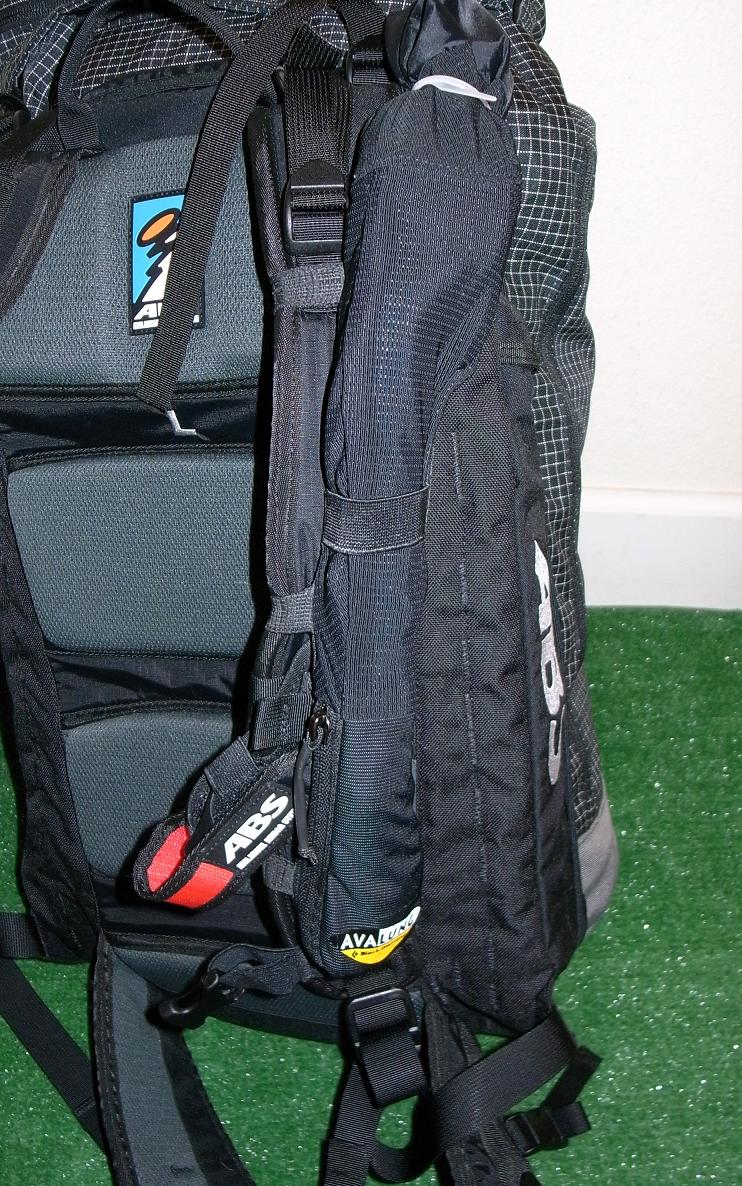

Here is how it came about. I got tired of wearing both the Avalung and ABS
pack. Too many straps, and I didn't like having to remove the Avalung every time I put on or took off a clothing layer (because
the Avalung has to go on the outside.)
So, I called Ron Rob at R2 Packs.
R2 is a truly custom pack maker. They work with you to design and build literally anything you want. (Although
they are now out of business)
I went to Ron with the idea of combining the avalung pack with the airbag pack.
The
task was made somewhat easier by the fact that the ABS airbag pack I have is modular. There is a standard frame, that contains
the airbag, and then you can zip on different pack bags of different volumes.
http://www.absairbag.de/vario.php?ch...c237c2f4033364So, we didn't have to tweak the frame or airbag portion of the
pack, we just had to figure out a way to incorporate the Avalung into the pack bag.
Initially, I thought that I could
just incorporate my existing Avalung into the pack, but after examining the BD Avalung packs, it became apparent that the
pack avalung has some important differences compared with the stand alone avalung. So, I bit the bullet and bought a BD Covert
avalung pack.
The Covert pack was canibalized for parts, and the avalung parts were incorporated into the pack bag.
The packbag itself was created by R2 from scratch, using lightweight fabrics, and was designed to my specifications, with
pockets sized to fit my shovel, probe, and snow saw, in addition to other features like a larger main compartment, hydration
pocket, and a floating lid that I could secure a helmet under (unlike the fixed lid on the ABS packbag.)
The final
finished product is pretty cool. The addition of the Avalung and the greater volume added about 8 ounces of weight,
brining the total weight of the pack to just over 8 pounds. That's 5 pounds heavier than a typical skiing pack,
but considering the large volume, the integrated Avalung, and the added safety of the airbags, I think it's worth the
weight.
Even though it is heavy, the pack is very comfortable, has excellent
balance for skiing, and distributes the load well.
I've used this pack on numerous day trips, and some multi-day overnighters. It's handled
all of these ski trips well.
Snowpulse 45L Lifebag (6 pounds, 15.8 ounces)
(Another airbag backpack.)
Snowpulse is one of two companies I’m aware of that makes airbag backpacks
for backcountry skiers. (The other company is ABS.) As outlined above, I already own an ABS pack, but I wanted to get
an airbag pack for my 16 year old son, who is going on a lot of backcountry trips with me this season.
Rather than get another ABS pack, I decided to get a Snowpulse instead.
The primary reason for this is that I like the design of the Snowpulse airbag. When deployed, the Snowpulse airbag forms around
your head and upper torso, providing some impact protection. The ABS airbag deploys to either side like wings. Particularly
here in Colorado, where there are quite a few trees in avalanche zones (compared with Europe, where much of the skiing is
above tree-line) I thought that having some extra impact protection might be a good idea.
| The Snowpulse bag surrounds the head and torso |
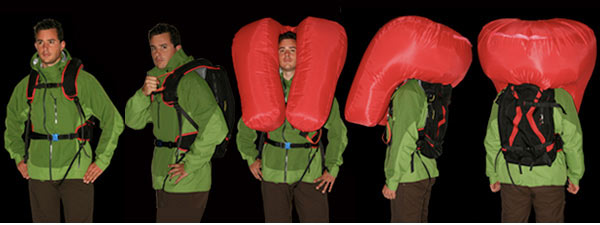
|
The Snowpulse gas canister that makes the airbag work is filled with compressed
air, as opposed to the ABS, which is powered by compressed nitrogen. The Snowpulse airbag is designed so that even if you
are buried, the airbags provide breathable air in a pocket around your head. This also seems like a good idea.
So, it was this innovation relating to the airbag design that led me to
purchase a Snowpulse, rather than buy the ABS.
Unlike the ABS, the Snowpulse is shipped with an empty canister, which you
have to get filled yourself. Scuba shops have the capability of filling the Snowpulse canister, but in order for them to do
it, you’ve got to have an adaptor. These adaptors are used by paintball guys to fill their paintball gun canisters.
It was harder than I thought to find one of these adaptors. The local sporting goods and paintball stores didn’t have
them. I ended up driving an hour away to purchase one, and it cost me $90. Only later did I look on Ebay, and see them for
$40. If you get one of these Snowpulse bags, I suggest that you buy a paintball adapter off of Ebay at the same time. That
way, when your bag shows up, you will have the ability to fill it.
A friendly scuba shop guy filled up the canister to 3000psi as directed.
However, the gauge on the Snowpulse canister read way too low. After reading the instructions again, I noticed that according
to the instructions, my airbag wouldn’t function correctly with the pressure that low. So, I went to another scuba shop, and had them fill the canister again to 3000psi. (The canister gauge still read low.)
We switched out gauges on the fill bottle, and pumped up the pressure to 3050psi. The Snowpulse gauge still read in the “too
low” zone.
I contacted the North American distributor for Snowpulse and told him about
this. He said that the gauge was not working correctly and also that a number of the gauges don’t work correctly (all
showing too low.) However, he assured me that the bag would work correctly if it had 3000psi in it.
I was somewhat reassured by this, but not entirely. I had watched the scuba
guy put the correct amount of air in the canister, but with the Snowpulse gauge not working, I have no way to accurately check
the canister pressure going forward. Maybe I’m just over cautious, but that seems like kind of a big deal to me. If
this was a pressure gauge on a super soaker, I wouldn’t really care. However, I kind of expect the gauge on a ($1000)
life-saving device to work. When the manufacturer can get this problem sorted, I’m going to ask them for a replacement
canister with a working gauge.
I attached the Snowpulse canister (a bit more difficult than with the ABS)
and finally the pack was ready for action.
When I took the new Snowpulse out skiing for the first time, I found that
the waistbelt buckle was broken. The pack comes with a quick-release
metal buckle that is supposed to keep the backpack on you even in the midst of an avalanche. However, the buckle kept popping
undone all day long. Finally, when I got back to the car and examined it, I found the problem. One of the springs in the buckle
was mis-aligned. Whoever had assembled the buckle had allowed the spring to be placed on the outside, rather than the inside.
So, the buckle would snap, however, a tug on the buckle would make it come undone. When I got home, I worked on the buckle
for a while with a screwdriver and a needle nosed pliers, and managed to get the spring in the correct position. So, the buckle
works now. (I’m glad I figured this out before I actually “needed” the backpack.)
Other than the quality control issues, I like the Snowpulse quite a bit.
The suspension is quite comfortable to carry. The pack frame is quite torsionally rigid, and doesn’t really flex with
you when you move, but I didn’t find that this hampered my skiing much. Compared with the ABS, I think that I found
the two suspension systems to be pretty comparable. Weight for the Snowpulse is 6 pounds 15.8 ounces, compared with 7 pounds
13.5 ounces for the ABS vario 30 (which is a 30 liter pack compared with the 45 liter Snowpulse) So, the Snowpulse saves a
substantial amount of weight compared with the ABS. The leg strap on the Snowpulse (which keeps the pack from riding up during
an avalanche) is easier to use than that on the ABS.
The Snowpulse has a good strap set up for carrying skis (which I used today
for the first part of our trip, hiking over the dirt road.) It also has a convenient pouch for a water bladder, and a hole
to stick the hose out of. It’s a zippered panel loading pack (the airbag design would seem to preclude a top loader
lay-out) with a main compartment, and another outside pocket compartment that appears designed to hold avalanche gear (it
fit my Ortovox Grizzly shovel perfectly, and there are places to put probes and other stuff.) There’s also a small,
padded pocket for stuff like keys, cell phone, etc.
I couldn’t figure out any good way to carry a helmet, except for inside
the main compartment of the pack.
The Snowpulse model I purchased was the 45 liter capacity model, in a size
long back length. In this size, there is more than enough room for a typical day trip, and even enough room for an over-nighter
if you’re going light. It seems like the perfect size for multi day hut trips.
If I were going to buy another airbag pack, would I buy an ABS or a Snowpulse?
I think I would buy a Snowpulse. Its airbag design, that protects the wearer’s head and torso, really seems to me to
be significantly better than the ABS design. I’m guessing that the quality control issues I’ve encountered are
due to the fact that this product is pretty new to the market, and Snowpulse doesn’t have the same experience that ABS
does. Hopefully, the Snowpulse manufacturer can get their gauge issues fixed. If I can get a canister with a working gauge,
I think I would be pretty satisfied with this piece of gear.
| Snowpulse Lifebag 45 |
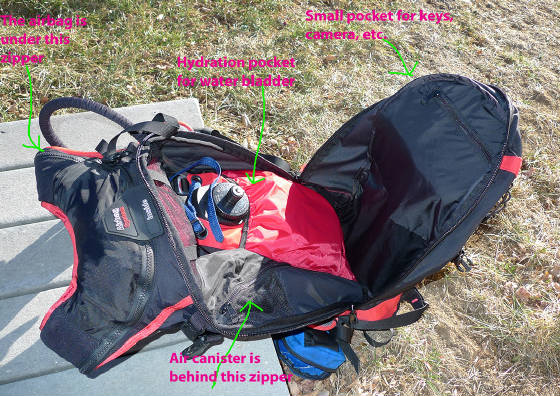
|
| Snowpulse Lifebag 45 |
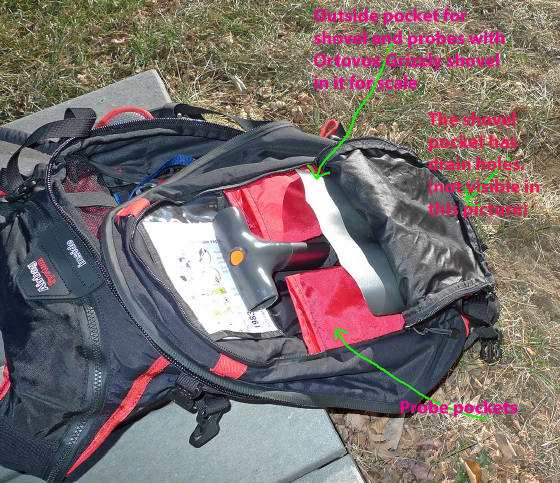
|
| Snowpulse Lifebag 45 |
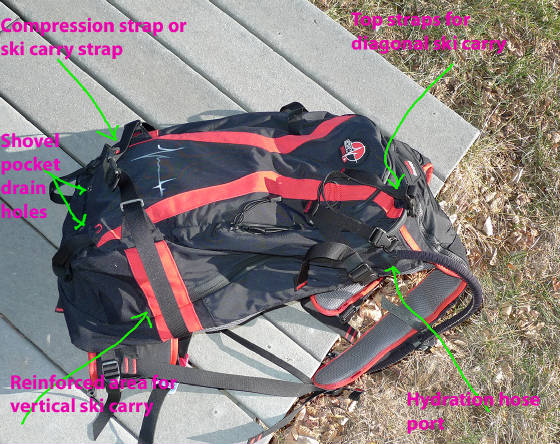
|
|

